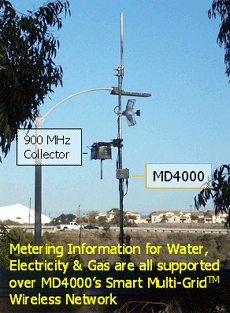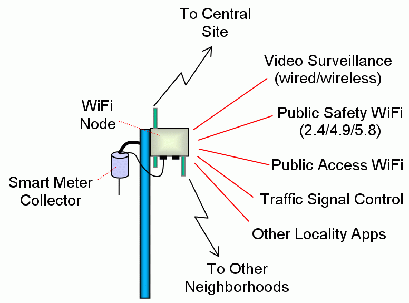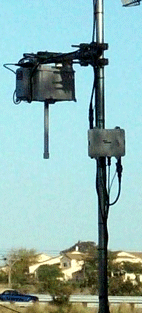Smart Grid Wireless Networks
(excerpted from
Smart
Multi-Grid Mesh Networks)
The Smart Multi-Grid Solution for Public Networks Smart Grid networks are currently receiving tremendous government attention and funding. The US Department of Energy says the Smart Grid "would integrate advanced functions into the nation's electric grid to enhance reliability, efficiency, and security, and would also contribute to the climate change strategic goal of reducing carbon emissions. These advancements will be achieved by modernizing the electric grid with information-age technologies, such as microprocessors, communications, advanced computing, and information technologies."
From a practical standpoint, the challenge is great: the entire electrical generating, transmission and delivery system must be upgraded while remaining in full operation. Much focus has been on the last mile of the problem –"smart meters" on the customer premise linking information to power suppliers and vice versa. This flow of data communications allows both consumer and producer to take actions that increase availability, and decrease costs and emissions. In the first phases, Automated Meter Reading (AMR) is the focus, but more sophisticated sources and uses for meter and sensor data are planned.
Isolated networks difficult to fund and support for many localities To date, many of the pilot projects funded to date treat the "Smart Grid" network in isolation. These wireless and/or wired networks provide only the digital connections that support the functions of the grid itself, such as AMR. A new, independent communications network must be installed to support this flow of data.
But the ideal for many localities is not to roll out yet another data network that must be individually managed and funded, but rather to consolidate applications in a single infrastructure that can support multiple public needs.
Some of these public needs might include: video surveillance, public safety communications, traffic signal controls, even public access WiFi networks to bridge the "digital divide", among others. Not only are localities discovering that it will be more efficient to provision and manage a single network that could provide Smart Grid connectivity along with one or more other applications over the same infrastructure, but it doing so allows multiple Federal and other funding sources to be tapped to provide the resources to build and support the network.
This is called "Smart Multi-Grid" and combines the networking necessary for the better management of the electrical grid with support for multiple other critical local government priorities.
Smart Multi-Grid concepts Smart Multi-Grid networks usually include a smart electrical grid component, typically implemented with intelligent wireless meters, as seen above. In the above diagram, a large number of individual premise electric meters (or other sensors) are linked to a Collector using data-over-AC or wireless technology (often 900 MHz). In basic Smart Grid networks, this data would then be transmitted to a central site via additional wireless or wired connections.
In the emerging Smart Multi-Grid network model, the data stream from one or more Collectors is linked wirelessly (or via cable) to a WiFi wireless mesh node. The wireless mesh nodes then provide the data link for the Smart Meter Controllers and provide the infrastructure for a wide variety of other applications.
As can be seen in the diagram of the Smart Multi-Grid installation above, the addition of WiFi mesh wireless nodes not only offers a cost effective-way to connect the Smart Meter Collectors, but also enables a broad range of other services. These additional services also open the opportunity for other funding sources, including the Broadband Stimulus and Transportation Stimulus programs, along with Smart Grid funding and resources.
Covering the distance Some of the highly desired applications, such as video surveillance, demand high performance in terms of high bandwidth and low latency and jitter. One of the challenges in delivering this type of applications outdoors is the need to connect over long distances with relatively few devices. This can be even more difficult to cost-justify if the wireless mesh nodes cannot supply high performance and low latency over many hops (node-to-node links).
Third-generation wireless mesh nodes (such as the Meshdynamics MD4000) are uniquely well-suited to the Smart Multi-Grid environment, as they add minimal delay and jitter at each node. In addition, sophisticated virtual LAN and other prioritization and security features can provide for the differing needs of each type of traffic, from the low speed access of the electrical Smart Grid to the high-demand needs of public safety and video surveillance.
Particularly in suburban and exurban environments, the ability to deliver a connectivity infrastructure for the electrical Smart Grid and other networks over long distances with relatively few nodes allows for a very attractive return on investment. The fact that these nodes operate securely in unlicensed RF spectrums also eases installation and speeds deployment.
Staged deployments supported Because funding may come from multiple sources over time, many localities will find the need to roll-out some applications earlier than others. The flexibility of the wireless mesh infrastructure in adapting to growing and changing networks is vital. In the case of the Meshdynamics MD4000, each node operates autonomously but cooperatively in creating the network topology. This means that the addition of new nodes to reach additional neighborhoods or installations is simply a matter of configuring security parameters, connecting antennas, and applying power. New nodes are added to the network automatically and seamlessly.
The same distributed dynamic radio intelligence that permits this easy expansion of the network also defends the network against interference or outages (such as a vehicle downing a pole). The remaining nodes adjust frequencies and topologies to maintain communications integrity.
Frequency flexibility The Meshdynamics MD4000 supports a variety of frequencies for ease in connecting to the wide variety of devices being deployed in the Smart Multi-Grid. WiFi at 2.4MHz is available for connecting to WiFi video surveillance cameras and all manner of end-user devices. 5.8 MHz WiFi provides a high-speed backhaul connection free of interference from typical consumer WiFi networks. Licensed Public Safety agencies may also be linked with 4.9 MHz technology, while 900 MHZ (under development) can make connections to electrical Smart Grid devices. Each device may be configured individually with a specific complement of radios supporting the desired frequency bands.
Pilot network successes Meshdynamics Smart Multi-Grid networks are already deployed and operating in multiple localities, with others in development or early testing. The first driver for the Meshdynamics WiFi infrastructure in one production network was public wireless Internet access and video surveillance. The Automated Meter Reading application has simply been added-on to the original network and additional Meshdynamics nodes added to reach new neighborhoods.
In this case, funding for the network is coming from multiple entities and sources, but the resulting infrastructure offers better resiliency and higher performance for all the supported applications.
Urban Smart Multi-Grid networks In the typical urban deployment, existing vertical support structures such as streetlight or traffic signal standards may be utilized to support the wireless mesh nodes and their antennas. Power may be tapped from streetlight or other existing sources.
In the diagram above, the street light standard also supports a video surveillance camera, which is directly attached to the wireless mesh node vie Ethernet. The WiFi client radio installed within the wireless mesh node provides mobile connectivity for the public or municipality departments.
An important advantage of the Meshdynamics wireless infrastructure is that higher densities of users or new neighborhoods may be easily supported by the addition of additional MD4000 wireless mesh nodes. The new nodes easily join the network with no re-engineering or other intervention.
Rural Smart Multi-Grid Networks The challenge in deploying Smart Grid to rural, exurban, and less-dense suburban areas is the challenge of covering wider areas. This often requires many hops (node-to-node connections). Previous generations of wireless mesh technology have performed poorly over many hops, but Meshdynamics' high-performance Third Generation wireless mesh technology has proved itself in many suburban and rural installations.
In the diagram above, widely spaced wireless mesh nodes provide both Automated Meter Reading (AMR) and home data services over a single physical infrastructure. The AMR Controllers are linked via 900 MHz frequencies, while WiFi data service is provided via 802.11 with Meshdynamics MD1000 Managed Premise Devices at each residence that are fully integrated with the backbone network for easy management.
In many less-dense areas, traditional Cable and Telco providers have not yet delivered broadband service. Utilizing new Federal stimulus funds, enterprising organizations are able to deliver a combination of services and benefits to these under-served communities.
The Smart Multi-Grid opportunity Localities have a once-in-a-generation opportunity to take advantage of multiple infrastructure funding programs to deploy Smart Multi-Grid technology to support multiple mission-critical applications. While "Smart Grid" is the high profile application of the hour, there is a unique opportunity to add public service, public safety, and other applications over the same network infrastructure with a Smart Multi-Grid architecture.
Meshdynamics is interested in partnering with forward-looking localities to begin deployment of Smart Multi-Grid networks today that will bring the long-term benefits of a variety of applications to citizens for many years to come.


